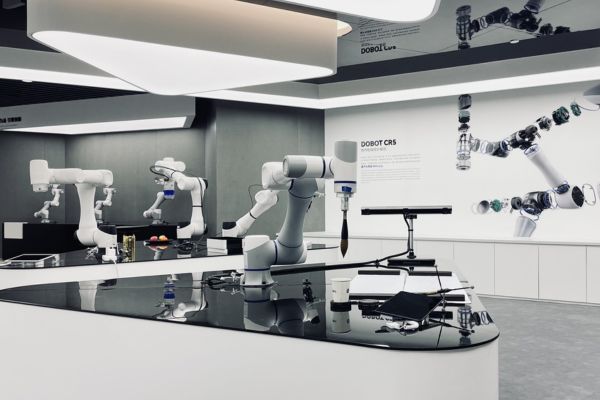As we step into 2024, the integration of advanced technologies, especially in robotics, is reshaping the landscape of warehouse operations. It also helps businesses stay ahead of the curve, which is a characteristic that’s imperative for businesses to thrive. Among the innovative solutions making waves is the Dobot CR Series of robotic arms, a game-changer in the realm of automation.

Dobot CR Series: Transforming Warehouse Operations
The Dobot CR Series represents a leap forward in robotic automation, offering a range of payloads to cater to diverse industrial needs. With options ranging from 3 kg to 16 kg and a remarkable repeatability of ±0.02 mm, these robotic arms are setting new standards for precision and efficiency. Designed for seamless human collaboration, the CR Series is not only easy to use but also flexible and adaptable across various industries such as healthcare and retail.
Easy to Learn. Fast to Deploy.
One of the standout features of the Dobot CR Series is its user-friendly design. The plug-and-play architecture allows for quick deployment, and users can choose from different accessories within the Dobot ecosystem. Whether programming through a graphical interface, scripting via smartphones and computers, or employing a drag-to-teach approach, the CR Series ensures a short learning curve. With a complete installation in just 20 minutes, businesses can have these robotic arms up and running within an hour.
Safe for Efficient Collaboration.
Safety is paramount in warehouse environments, and the CR Series excels in this regard. Boasting 22 built-in safety features and certifications like ISO 13849 and TS15066, these robotic arms are equipped to collaborate efficiently with human workers. The inclusion of sensors with adjustable collision detection levels ensures adaptability to diverse application scenarios. The optional SafeSkin, with its innovative pre-collision sensing technology, takes human-machine collaboration to new heights by actively enhancing safety and efficiency.
Infused with AI Technology.
The Dobot CR Series goes beyond basic automation with its all-perceptive AI control technology. By combining vision, force, and voice controls into one, these robotic arms can imitate human hand motions. The inclusion of trajectory tracking and a portable learning algorithm further enhances their capabilities, making them well-suited for intricate tasks. This makes the Dobot CR series robots suitable for automated sorting operations on conveyor lines.

Advanced Algorithm for Higher Performance.
Precision and stability are non-negotiable in warehouse automation. The CR Series excels in this aspect with industry-leading DH parameter compensation technology, ensuring a remarkable repeatability of ±0.02 mm. Vibration suppression and True Motion algorithms guarantee precision and stability, even during complex movements.
Open Ecosystem for Scalability.
The Dobot CR Series is not just a standalone solution but part of an open ecosystem. Plug-and-play connectivity allows for the integration of various grippers, cameras, and sensors. With support for secondary development on over 20 platforms, businesses can tailor these robotic arms to their specific needs. Task-specific software packages cover a broad spectrum of operations, including loading and unloading, assembly, screwdriving, polishing, and more, spanning eight major industries.
Types of Robotics and Automation in Warehousing
The Dobot CR Series is just one example of the evolving landscape of warehouse automation. Various types of robotics and automation are being employed to streamline operations and enhance efficiency across the board.
- Automated Guided Vehicles (AGVs)
AGVs are autonomous vehicles equipped with guidance systems, such as lasers or markers, to navigate through warehouse spaces. They are commonly used for material transport, reducing the need for manual labor and increasing the speed and accuracy of transportation tasks. - Pick and Place Robots
These robots are designed to handle the picking and placing of items in warehouses. Using advanced computer vision and gripping technologies, pick and place robots can efficiently manage the movement of products from shelves to order fulfillment areas. - Autonomous Mobile Robots (AMRs)
AMRs are mobile robots that can navigate their environment without the need for fixed paths or external guidance systems. They are highly flexible and can be reprogrammed for different tasks, making them valuable in dynamic warehouse environments. - Warehouse Execution Systems (WES)
WES integrates and optimizes various warehouse processes, including order picking, inventory management, and transportation. It acts as a centralized control system, ensuring smooth coordination between different automated systems within the warehouse. - Collaborative Robots (Cobots)
Cobots, like the Dobot CR Series, are designed to work alongside human workers. They are equipped with advanced safety features, making them suitable for tasks that require close collaboration between humans and machines. Cobots can be programmed to perform a wide range of tasks, from assembly to packaging.
Embracing the Future of Warehousing
As we delve deeper into 2024, the integration of advanced robotics and automation is reshaping the warehousing landscape. The Dobot CR Series, with its versatility, safety features, and AI integration, stands out as a prime example of how technology can enhance efficiency while ensuring a safe and collaborative work environment. Combined with other types of robotics and automation, businesses can create a seamless and optimized warehouse operation that meets the demands of the modern era. The future of warehousing is here, and it’s defined by innovation, precision, and a commitment to progress.